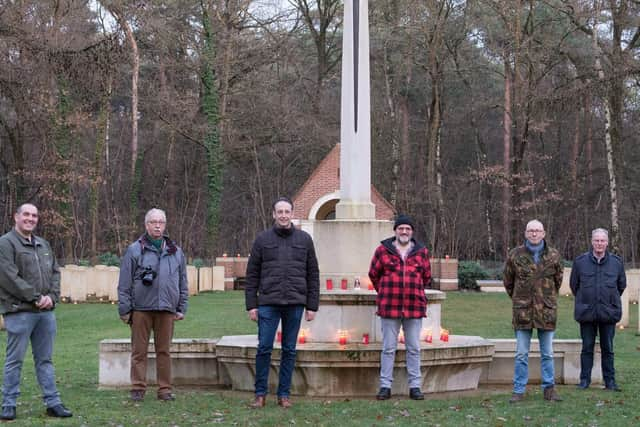Bid to trace family of Burnley Second World War hero who gave his life in ferocious tank battle
and live on Freeview channel 276
Overloon, a sleepy village near the Dutch-German border is now a calm and peaceful place, but in September and October of 1944 was the scene of a fierce and bloody tank battle between a combined British and American force pitted against the Germans, which resulted in the deaths of around 2,500 men, among them John Mason Foster from Burnley
Now, six inhabitants of Overloon have started a work group to add a face and hopefully memories to each grave.
Advertisement
Hide AdAdvertisement
Hide AdOscar Huisman (51) and Leo Janssen (66) believe that simply remembering these men once a year is not enough. The fallen soldiers of the Second World War deserve more. “If it were not for them,” says Oscar Huisman, “we would all be speaking German now.”


The dedicated group of enthusiasts have already discovered that John Mason Foster married Lily Irene Foster in Marlborough, Wiltshire, where he most probably was stationed as a member of the Lincolnshire Regiment.
After John was killed during the battle of Overloon, on October 14th, 1944, his wife remarried and contacts with the Foster side of the family were lost. John's parents were John D Foster and Evelyn Mason.
Leo said: "As a member of a work group, we are trying to find relatives of the 281 soldiers, buried at the CWGC cemetery in Overloon. These men, mostly killed during the Batlle of Overloon, deserve more than a cold tombstone. We are trying to find relatives of them and hope they have pictures and stories.
Advertisement
Hide AdAdvertisement
Hide Ad"We should like to get in contact with a relative from the Foster side."
Besides Huisman and Janssen, the Overloon War Cemetery work group includes enthusiastic amateur archivists Tonnie Ebben, Iwan van Dijk, Arno van Dijk and Piet Peters.
“Our goals are simple,” Oscar added, “first a photograph, second the story behind it.” Third, the adoption of the graves.
As children, both Janssen and Huisman developed a fascination for the war - planes in particular for Janssen, personal stories for Huisman.
Advertisement
Hide AdAdvertisement
Hide AdLeo said: “My father was a blacksmith in Stevensbeek. The Germans forced him to cut crashed planes into pieces, he had no choice. The cut parts then went to German factories to produce new war materials. My father did not like to talk about this in later life, as he was not at all proud of his wartime experience.”
Like all the other members of the group, Huisman has studied the war in detail.
“Some of the historical facts are no longer recalled by people in Overloon. We must keep the history alive. Having read about the American initiative in Margraten cemetery, where volunteers searched for more than 8,000 pictures, I am sure that something similar should be possible for the 281 graves in Overloon. This is also about the pride I have in my hometown.”
During the battle of Overloon, in October 1944, 2,500 allied forces and 600 civilians were killed. The number of Germans killed has, so far, never been confirmed.
Advertisement
Hide AdAdvertisement
Hide AdIn the Overloon War Cemetery are buried 281 men, mainly from the UK. “Records show that the majority of the soldiers were not killed in the Overloon area,” states Oscar Huisman. “They come from more than 20 temporary cemeteries. Some bodies were even reburied several times.”
In the process, sadly, lots of information disappeared or was lost. Dog tags (identity discs) became unreadable in the ground or were removed. Strangely enough, there is now a trade in these relics.”
“At the moment,” concludes Huisman, “we have some 34 pictures…but the first 34 are no doubt much easier to find than the last 24. That is why we want to get in touch with as many people as possible to secure more information on this subject.”
“Some kind families adopted graves in 1947,” says Leo, “mainly to show their respect and gratitude. They may have some useful information for us, although we should really have started this search some 50 years earlier, as there now hardly any direct witnesses from that time.”
Advertisement
Hide AdAdvertisement
Hide AdIdeally, the photographs and their associated stories should have a permanent spot on the graves. This will not be easy, as the cemetery is owned by the Commonwealth War Graves Commission (CWGC) and it is forbidden to place any permanent objects there.
The CWGC want to keep the cemetery looking solemn and subdued, not to mention neatly maintained, and all 43 CWGC cemeteries look the same. Leo Janssen is still negotiating with the Commission to find the best solution to this question.